This post may contain affiliate links. Read our disclosure policy.
It can be so frustrating to put time and effort into baking a cheesecake, only for it to crack all over while baking. The solution? Baking the cheesecake in a water bath!
As you’ll see in my side-by-side comparisons below, cheesecake baked in a water bath is SO much smoother and creamier than cheesecake baked without a water bath.
I’ve included step-by-step instructions and all my tips and tricks for making a professional quality water bath, so you can make the perfect cheesecake.
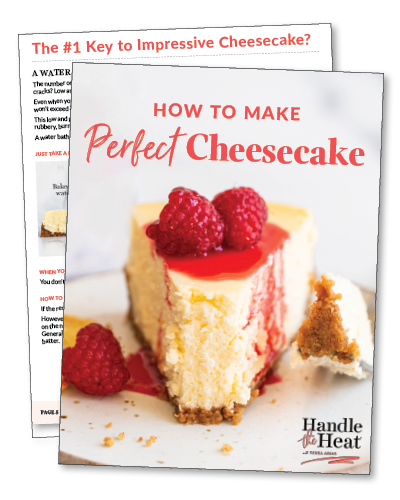
Free Cheesecake Guide!
Discover the #1 secret for flawlessly smooth, luscious cheesecake in this FREE guide. Bake compliment-winning cheesecakes all the time!
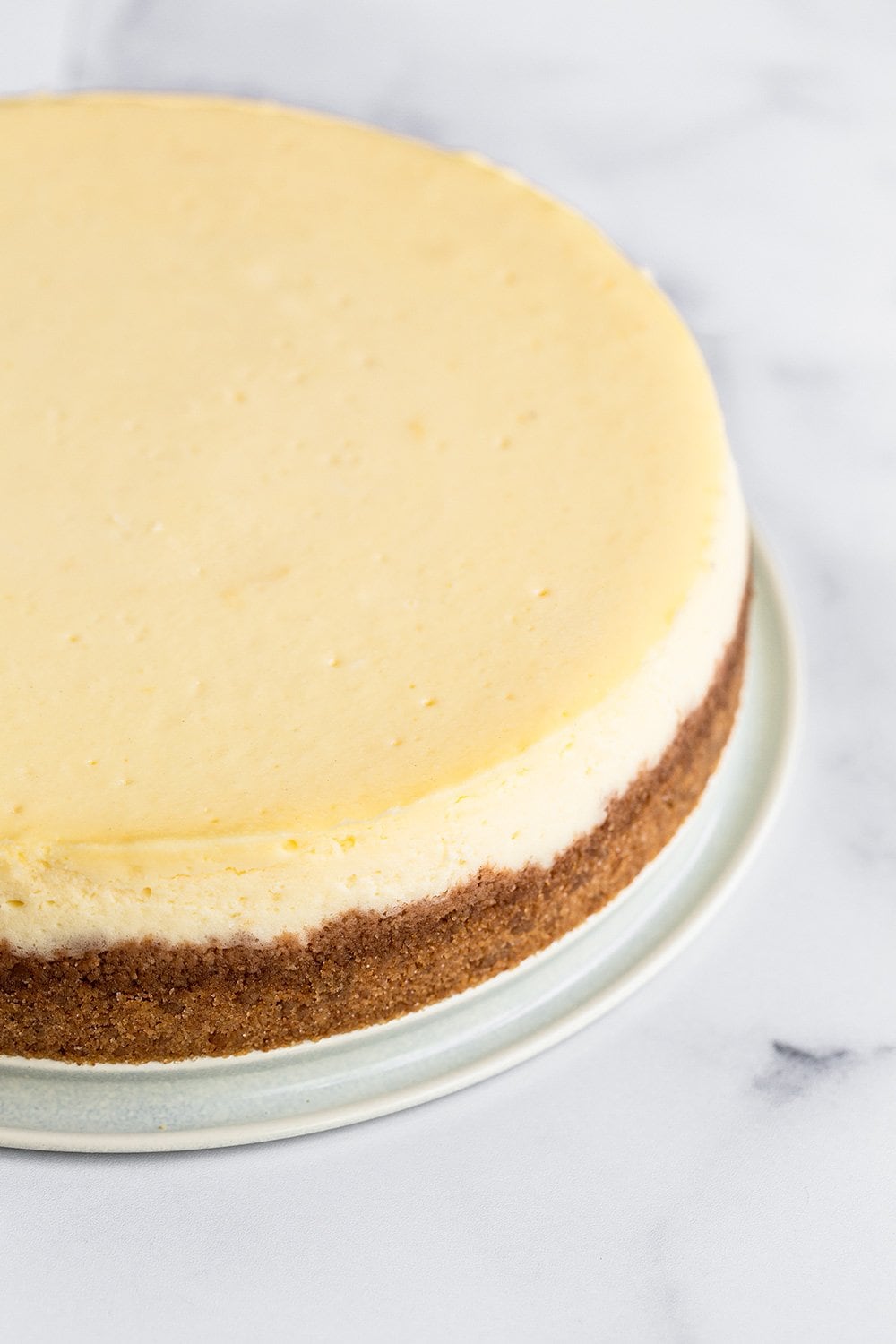
No cracks. No uneven baking. No sunken centers. No water seepage or soggy bottoms. Just a silky-smooth, stunning cheesecake that’s 100 times better than The Cheesecake Factory.

Sprinkle of Science
Tips for Cheesecake Water Baths
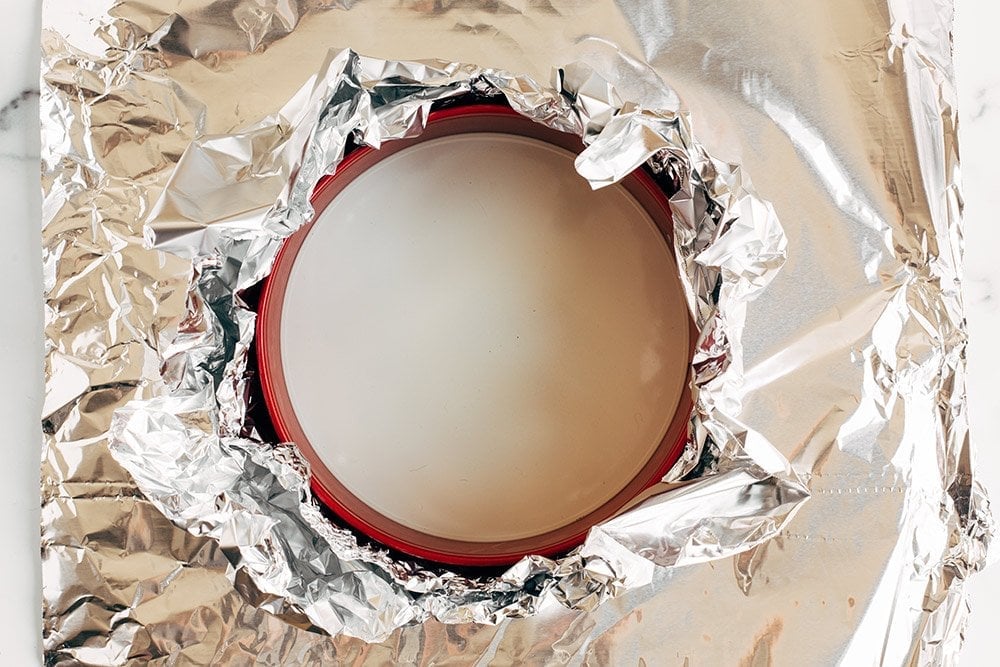
What is a Water Bath?
A water bath is a method for gently baking a cheesecake in its pan inside another pan filled with boiling water in the oven. It’s also called a bain marie. It’s used for a lot of custard preparations, such as flan and crème brûlée. Cheesecake is essentially a custard (not a cake!) since it’s so rich with dairy and eggs.
Why is it Important to Bake Cheesecake in a Water Bath?
The number one key to perfectly smooth, luscious, and creamy cheesecake that bakes evenly and without cracks? Low and gentle heat!
A water bath is the best way to ensure this baking environment. Even when you set your oven to 325°F to bake a cheesecake, the temperature inside the water bath generally won’t exceed 200°F.
This low and gentle heat evens out the baking so that the outside of the cheesecake doesn’t become tough, rubbery, burnt, or curdled before the inside can finish baking.
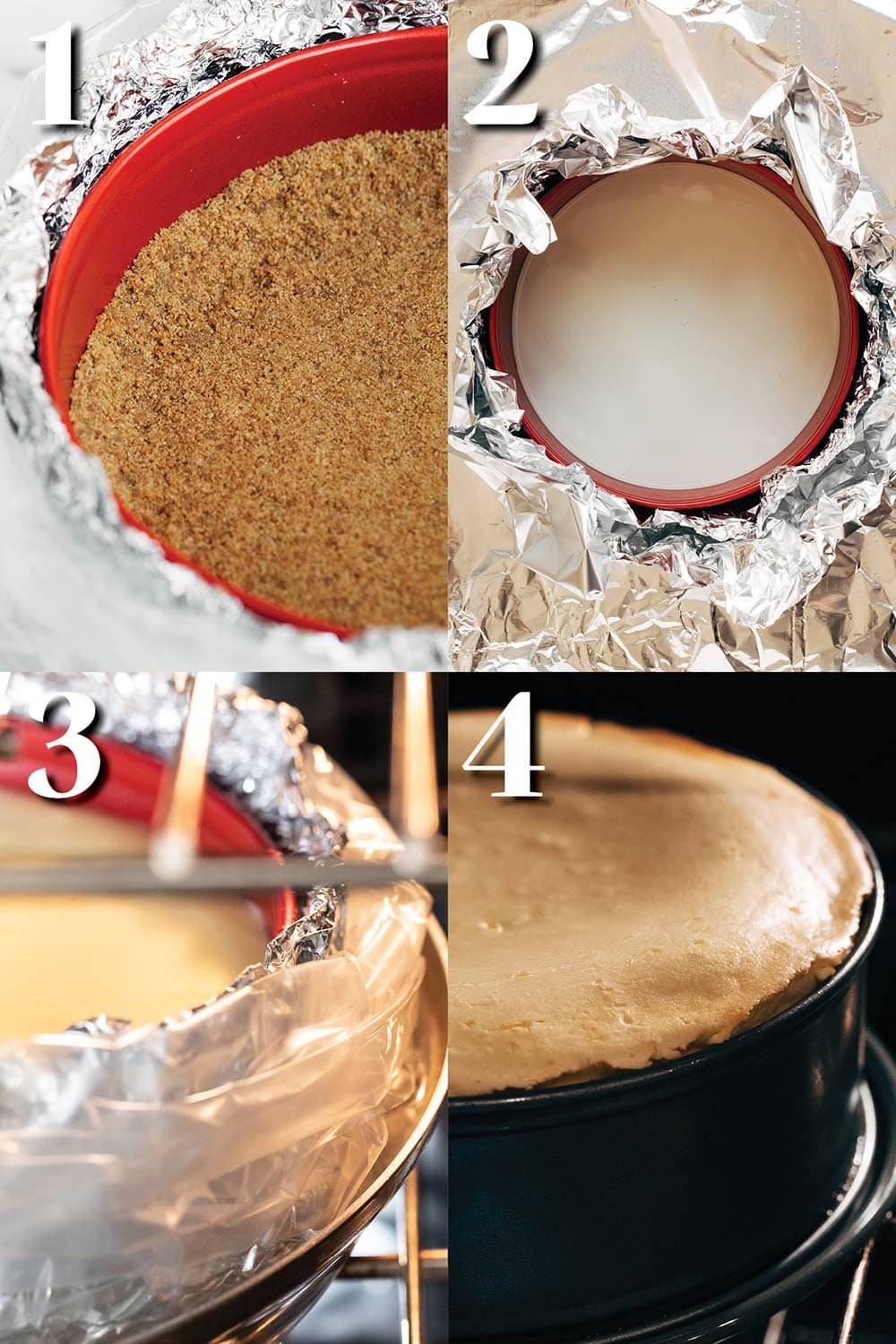
Cheesecake Baked in a Water Bath vs. Cheesecake Baked Without a Water Bath
A water bath is truly the best way to bake a flawless cheesecake. Just take a look at the side-by-side comparison pictures below!
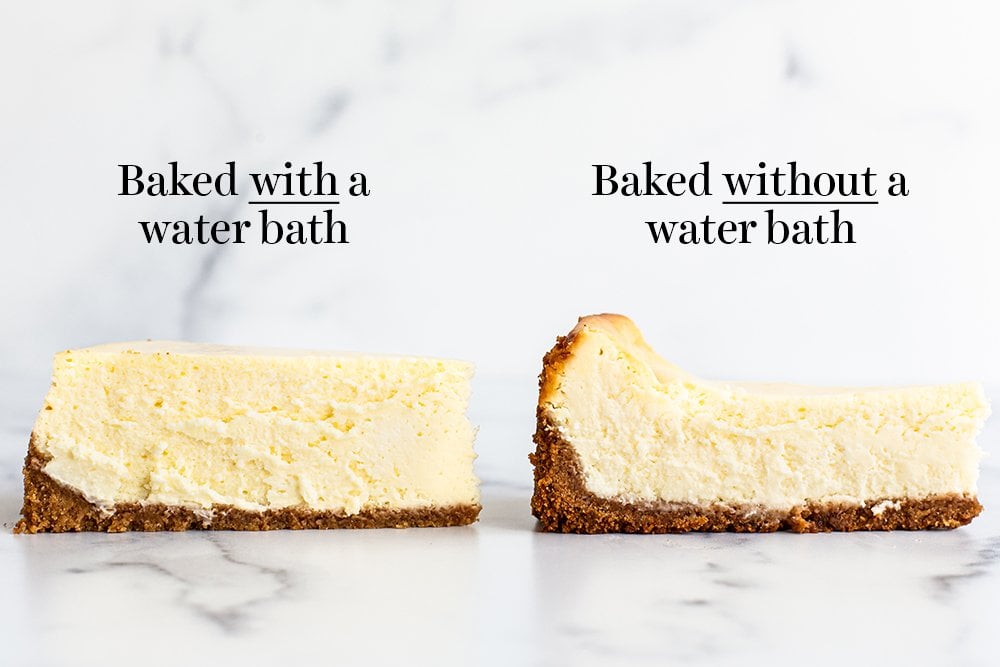
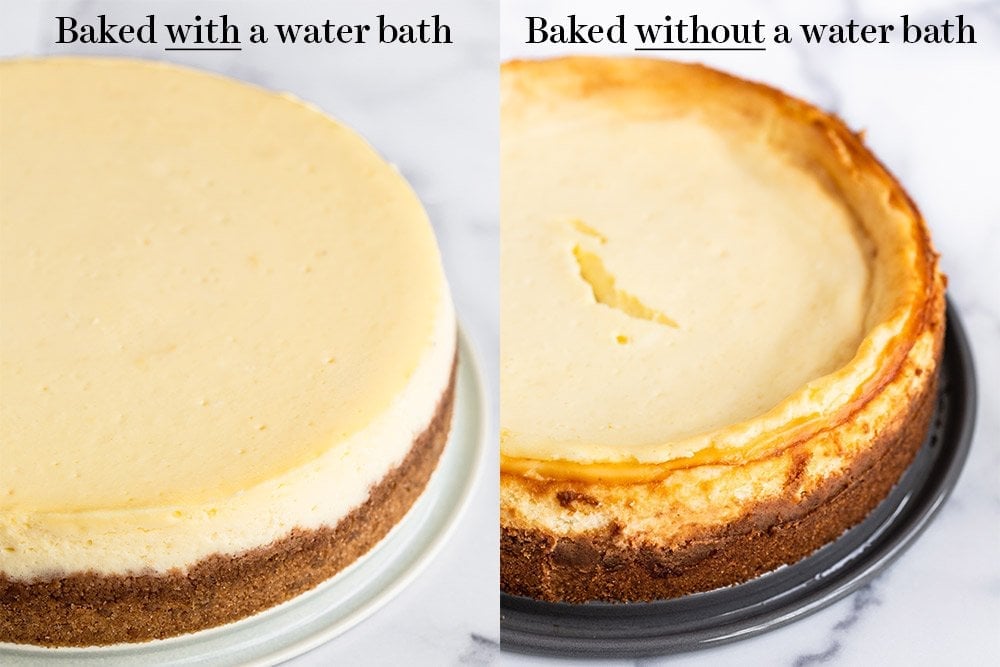
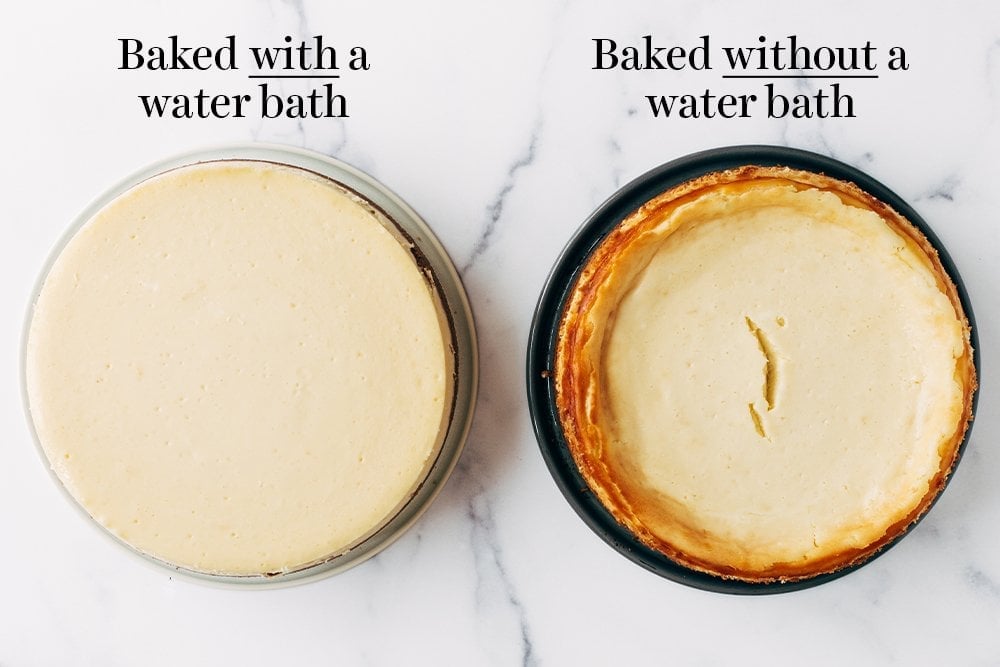
When to Use a Cheesecake Water Bath?
You can use a water bath for any full-size cheesecake recipe. Especially Classic Cheesecake, or any recipe where you really don’t want cracks.
When You Don’t Need a Water Bath
You don’t need one for cheesecake bars, mini cheesecakes, and, of course, no-bake cheesecake recipes. Bars and mini cheesecakes are thinner than a normal cheesecake, so they cook more evenly.
How to Use a Water Bath When the Recipe Doesn’t Call For One
If the recipe doesn’t call for a water bath, you don’t need to use one.
However, if you want all of the amazing benefits listed above, then simply prepare the water bath as directed below. Since the water bath cooks more gently, you’ll likely need to increase the baking time. Generally, you can bake at 325°F for about 1 hour 15 minutes, depending on the volume of cheesecake batter.
Equipment Needed For a Water Bath
- A high-quality springform pan: Even the best springform pans aren’t truly “leakproof,” no matter what their packaging claims. However, it’s important to have one that’s heavy duty and high quality for durability and to avoid rusting.
- Larger baking pan, cake pan, sauté pan, or roasting pan: This is the water bath pan, so it must fit the springform pan comfortably inside. You can also use a large disposable foil pan placed on top of a rimmed sheet pan. If you don’t have a pan big enough, I’ve listed some alternative options at the bottom of this article.
- Wide heavy-duty aluminum foil: This helps prevent leaks. I usually buy this from Costco. It’s important for the foil to be wider than the diameter of the springform pan so water doesn’t seep through the seams and cracks of the foil.
- Heat-safe oven bag or slow cooker bag: This is an optional bonus. Wrapping the springform pan in a heat-safe oven bag really helps ensure no water seeps in! Much more foolproof than foil. I like to use BOTH to truly seal off the water.
- Boiling water: A kettle with a spout is the best way to quickly boil water and safely pour it into the roasting pan without splashing any in the cheesecake batter.
How to Prevent a Water Bath From Leaking
Using a high-quality springform pan, wide heavy-duty aluminum foil, and an oven bag is the best way to all but guarantee you won’t have any leaks!
Alternatives to Using a Cheesecake Water Bath
These methods are perfect if you don’t have a roasting pan large enough to comfortably fit your springform pan inside – just note that they may not produce quite as smooth, crack-free results as using a water bath.
1. Low Heat & Slow Baking Time
Since the effect of the water bath is to cook the cheesecake custard filling slowly and gently, an easy alternative is to bake the cheesecake without the water bath but in a 275°F oven for 1 hour 45 minutes. This technique can be a bit tricky and not always a guarantee against cracks if your oven is older, as shown in the comparison below:
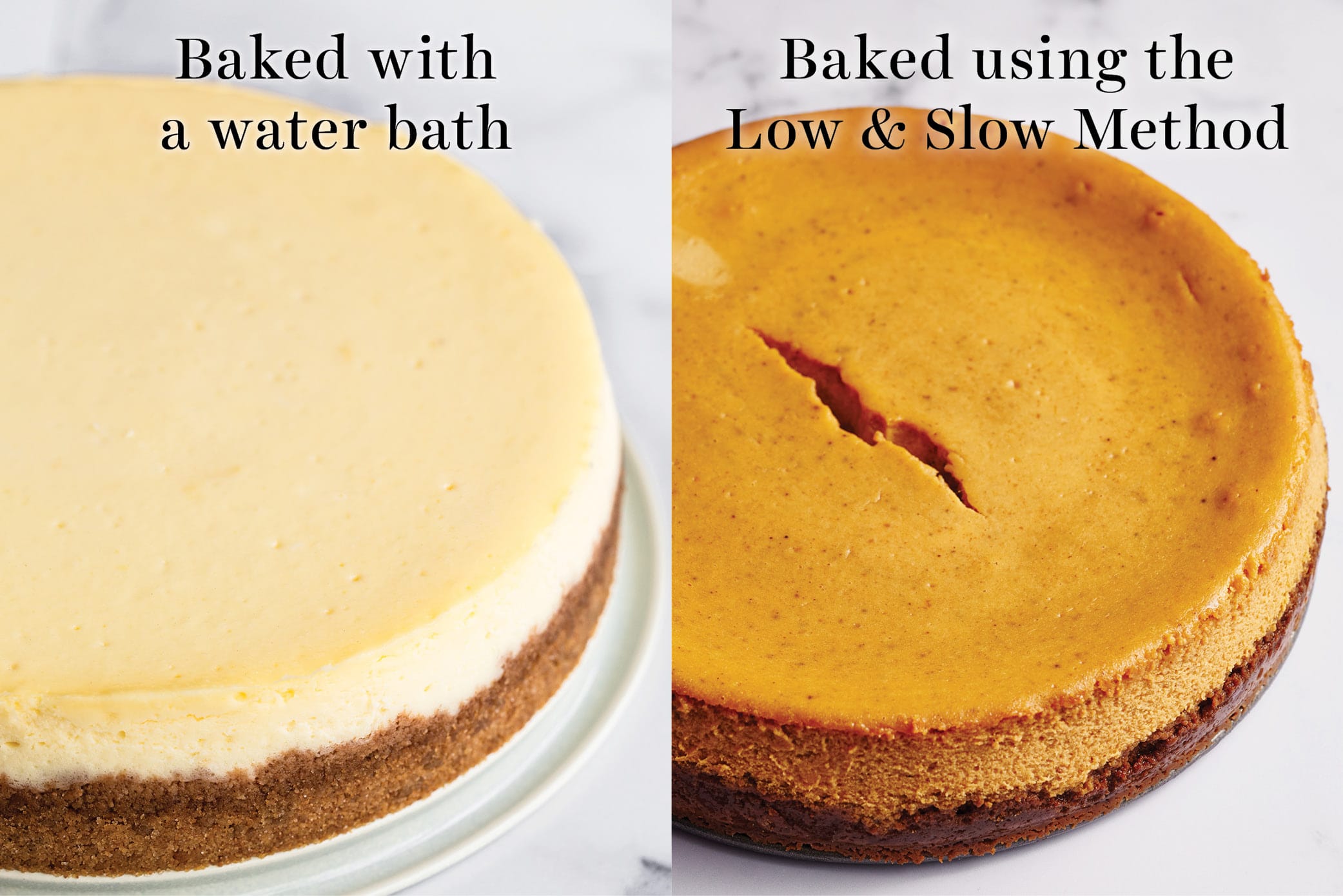
On the left is my Classic Cheesecake recipe baked with a water bath. No cracks. On the right is my Pumpkin Cheesecake recipe baked low and slow. You can see a crack still formed.
Interestingly, when I use the “low and slow” method in my home oven with my 5-year-old electric oven, the crack is usually pretty minimal.
However, when I used this method at my photographer’s house with her older oven, the crack was more pronounced.
So if your oven is old and doesn’t maintain a low temperature consistently and accurately, this may not be the best method for you. However, if you have a newer or more accurate oven then this may be perfect for you!
Not sure how accurately your oven maintains temperature? Check out my Ovens 101 article here.
2. Tray of Water on the Bottom Oven Rack (Beneath the Springform Pan)
This is perfect if you don’t have a large enough pan to act as the water bath vehicle. OR, if you don’t have heavy-duty aluminum foil or oven bags and are worried about water leaking in.
Simply place a tray of boiling hot water on the bottom rack of your oven, beneath the middle rack where your springform pan bakes.
Even though you’re not baking the springform pan directly in water with this method, it’s still a good idea to wrap the pan in foil to help shield it from the oven’s heat.
Delicious Cheesecake Recipes to Try:
- Ultimate Classic Cheesecake – the perfect creamy, classic cheesecake!
- Ultimate Peanut Butter Cheesecake
- Lemon Cheesecake
- Oreo Cheesecake
- Death by Chocolate Cheesecake
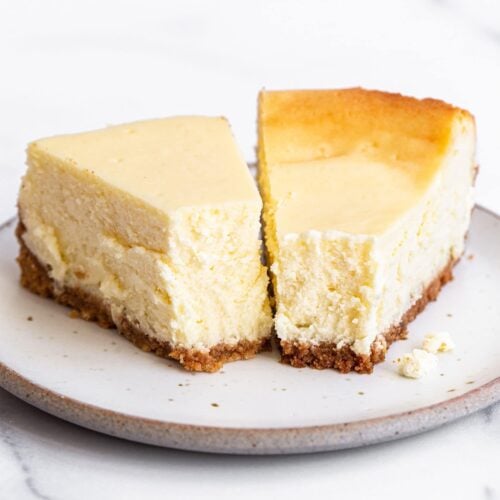
How to Prepare A Cheesecake Water Bath
Email This Recipe
Enter your email, and we’ll send it to your inbox.
Ingredients
- 1 high-quality springform pan
- 1 larger baking pan, cake pan, sauté pan, or roasting pan
- wide heavy-duty aluminum foil
- heat-safe oven bag or slow cooker bag
- boiling water
Instructions
Bake your graham cracker crust:
- Prepare your crust, press it into your springform pan, and bake as the recipe directs. Let cool completely. You can do this step first if it’s awkward to press the crust into the pan with the foil already wrapped around it. Also, the oven racks can pierce your foil wrapping which defeats their entire purpose.
- Alternatively, you can wrap your pan in foil & bag before pressing in the crust if you don’t want to wait for the pan to cool down completely after baking the crust to prepare the water bath. It’s personal preference, either way will work.
Prepare your springform pan:
- To seal off the springform pan, place a large square of heavy-duty aluminum foil underneath the pan. You want the wide heavy-duty stuff that creates bigger sheets of foil to completely encompass the base of the pan. Gently fold the edges up and around the pan. Repeat twice so there’s three sheets of foil, to ensure a waterproof seal.
- Optional Bonus Step: Place the foil-wrapped springform pan inside an oven bag. Roll down the oven bag and fold the top down so it’s flush with the edge of the pan.
- Bring your kettle of water to a boil.
- A kettle is really the best option since you’ll avoid spills and splashes. If you don’t have one, bring your water to a boil in a pot then pour into a large heatsafe glass measuring cup with a spout.
Prepare your water bath pan:
- Once your crust is cooled and your water is boiling, pour the cheesecake batter into the cooled springform pan. Place the springform pan inside your bigger water bath pan. Place both pans on the middle oven rack into the preheated oven.
- Carefully pour the boiling water into the water bath pan, pouring only halfway up the sides of the springform pan. You want enough water that it won’t evaporate, but not so much that it’ll splash into your batter.
Bake as the recipe directs:
- When baking a cheesecake in a water bath, the directions are generally to bake at 325°F for 1 hour to 1 hour and 15 minutes. The cheesecake is done when the top looks dry but the center still wobbles and jiggles like jello. It should not be liquidy at all.
Turn off the heat and crack the oven door to cool:
- This step is optional, but further helps to prevent cracks from forming. Turn off the oven, crack open the oven door (a wooden spoon can be helpful to keep the oven door open), and allow the cheesecake to cool inside the oven undisturbed for 30 minutes to 1 hour.
Remove the springform pan:
- Carefully remove the springform pan from the water bath. Unwrap the foil and transfer the pan to a cooling rack. Run a thin-bladed flexible knife around the edge of the cake to make sure it's not sticking to the sides (which can cause cracks as it cools).
Cool, then chill:
- Let the cheesecake cool completely to room temperature on the rack before moving to the fridge to chill. Once chilled, remove the springform pan and serve.
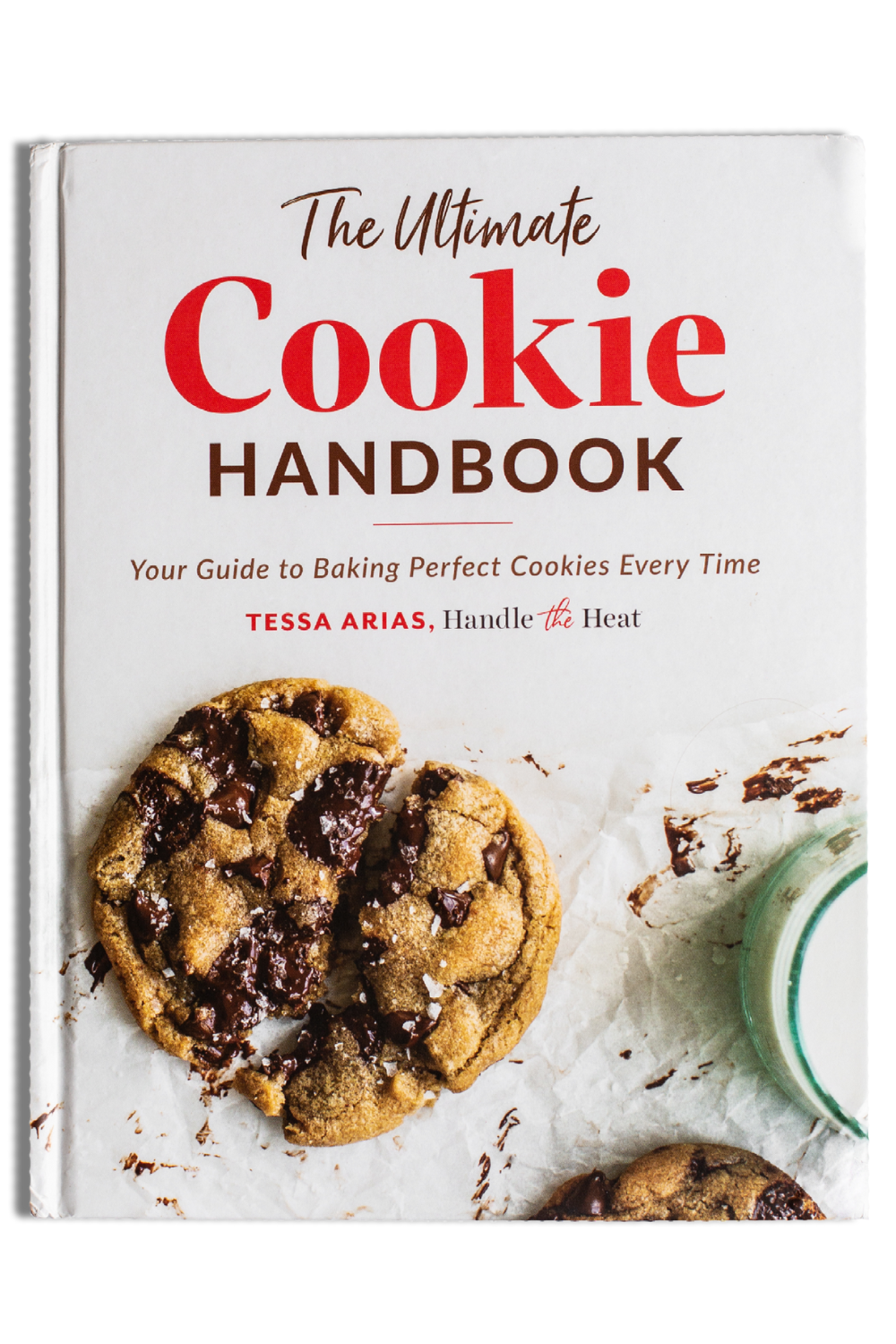
The Ultimate Cookie Handbook
Learn the sweet SCIENCE of cookie baking in a fun, visual way to customize your own recipes frustration-free. Plus, my best 50+ homemade cookies!
Photos by Ashley McLaughlin.
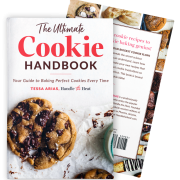
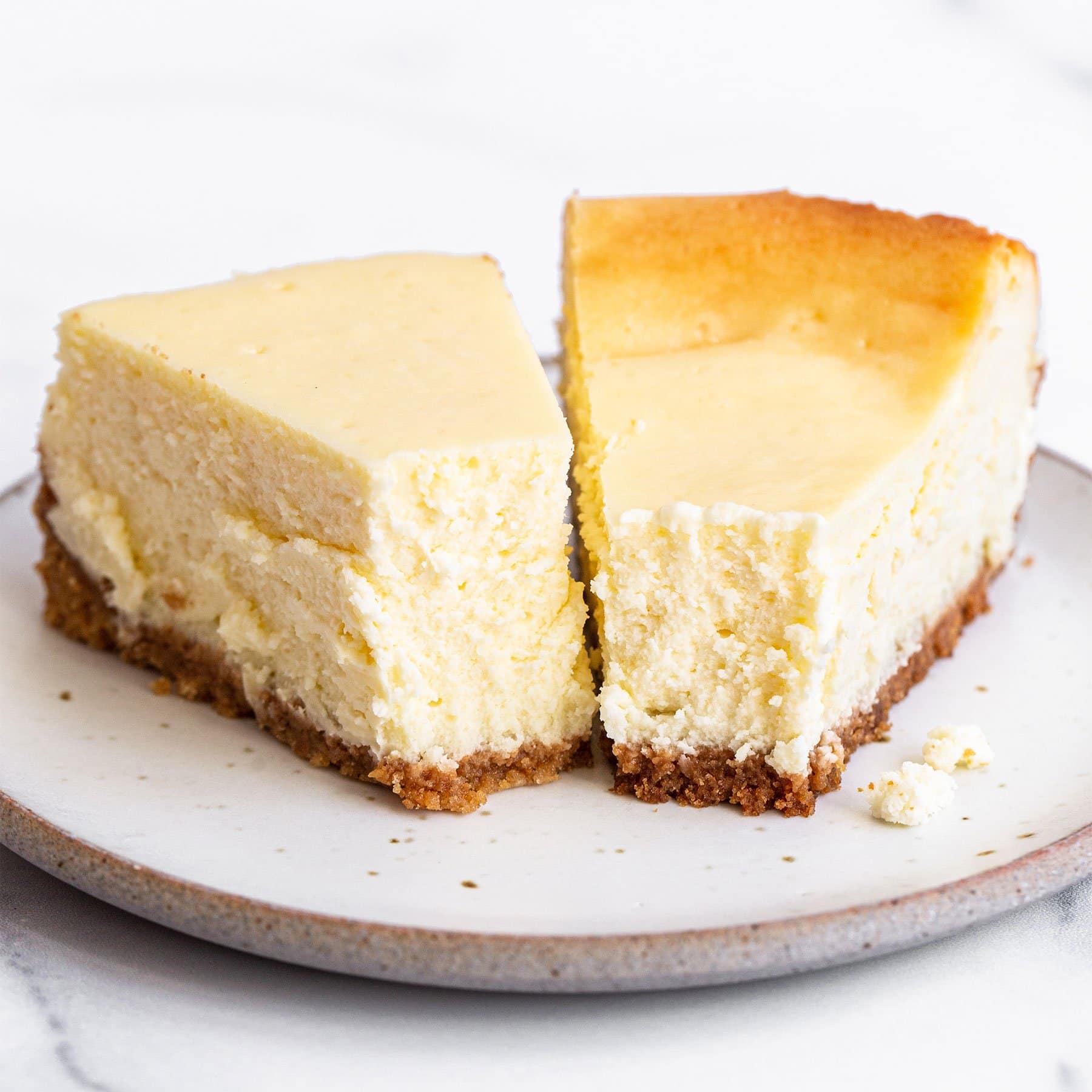

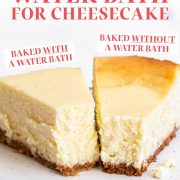
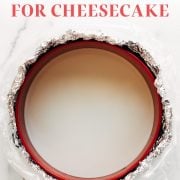
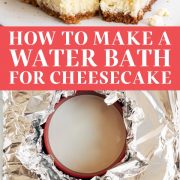
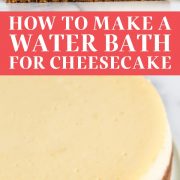
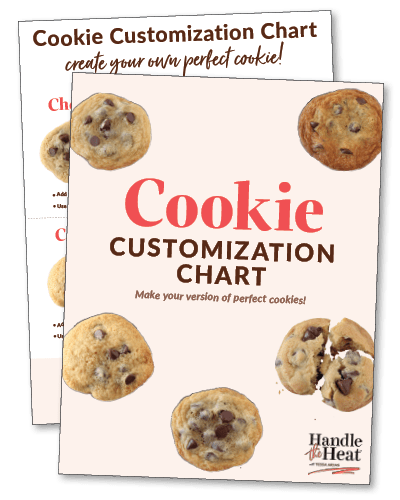
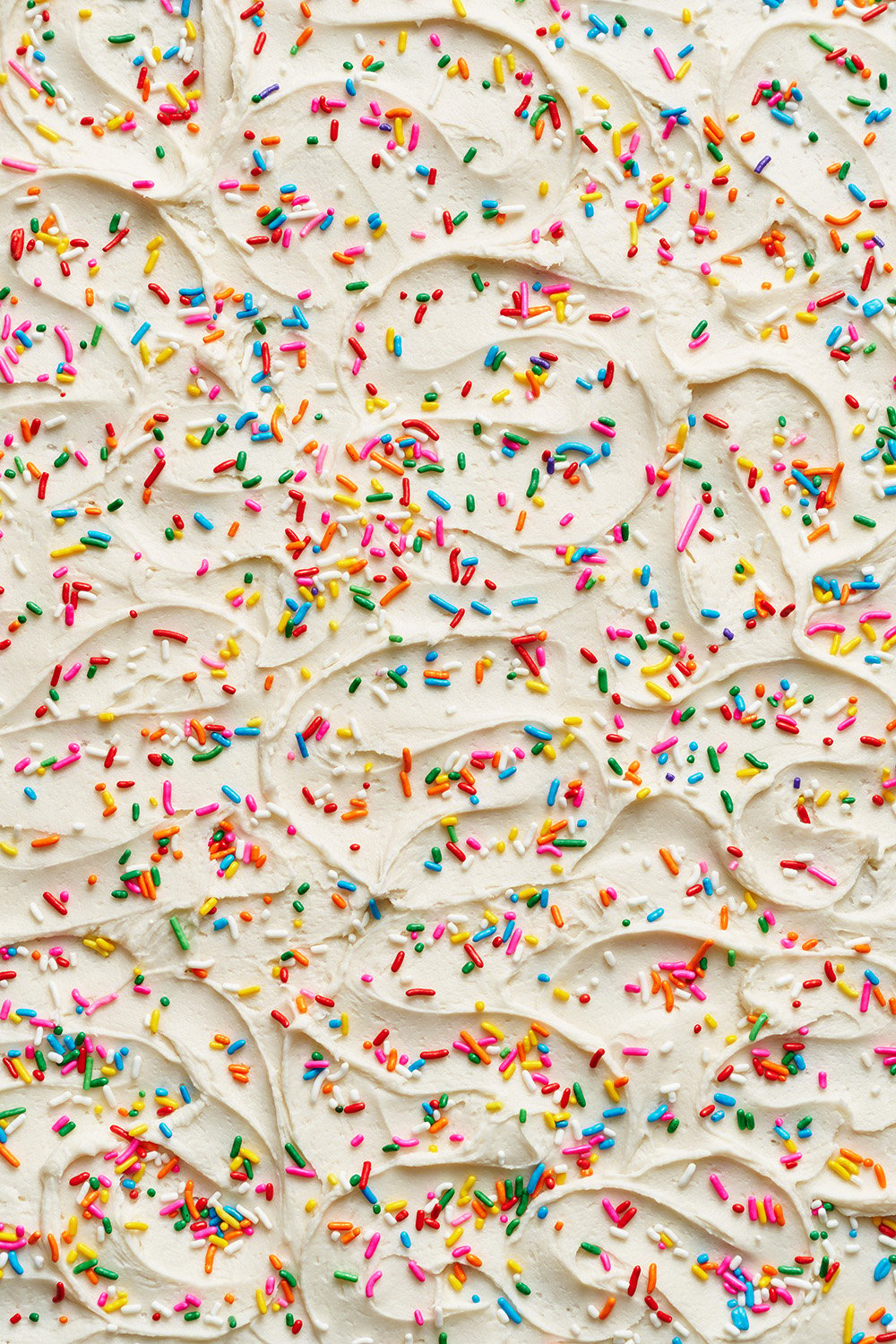
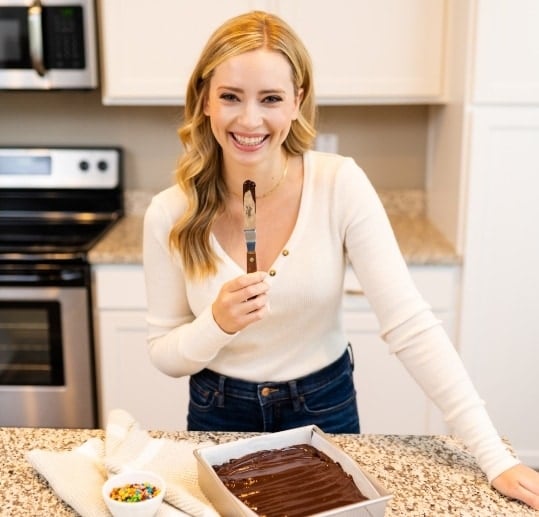


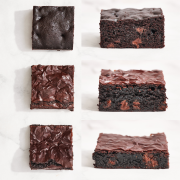
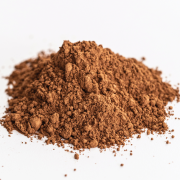
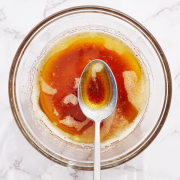

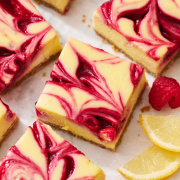
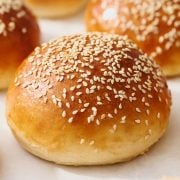
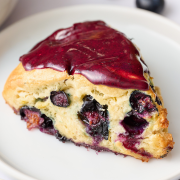








Thank you SO MUCH for the suggestion of using a slow-cooker bag to help prevent leaking! I’ve been making a wonderful Nigella Lawson cheesecake for 10 years but the darn water bath sometimes leaks into the pan – and I use a good quality pan. The next time, I’m adding a slow-cooker bag to my equipment. THANK YOU!
Could you share what you think are the best springform pans and foil (brand wise)?
Hi Nicki! Here’s the springform pan Tessa uses, which is also linked above in the pink tip box above. She uses wider heavy-duty foil, like this Reynolds foil here. Also, an oven-safe oven/slow-cooker bag will further help prevent leakage – like this one. I hope this helps! Happy baking 🙂
The best way ever!
Thank you for these tips. I do however have a question have you ever baked more than one cheesecake at a time?
I was wondering if it would be possible to put two cheesecakes on the top rack and a water bath on the bottom rack.
Hi Lori! We have not tried baking two cheesecakes at once. I would worry that this would make it difficult for the air to circulate properly in the oven, preventing an even bake – but of course, feel free to experiment and let us know how it goes if you give that a try!
Good day,
Just a quick question. Whats better top and bottom heat or circulating air ? 325 F is that 160 Grad ?
Best regards Ulf
Hi Ulf! It depends on what you’re baking when choosing convection vs. conventional baking methods (more information in Tessa’s article on ovens here). Specifically regarding cheesecake, conventional is best, to avoid the air blowing around the cheesecake too much and hopefully ensure a perfect cheesecake. If your oven has the ability to bake from either the bottom or top using conventional cooking, the heat from the bottom is best with cheesecake, to ensure the top doesn’t overbrown. If it’s top and bottom, watch your cheesecake closely and tent loosely with foil if browning starts to occur. The most important thing with any baking is to ensure your oven rack is positioned in the middle of the oven, to ensure your baked goods aren’t too close to the heat source, and to allow an even distribution of browning. I hope this helps, and I hope you’ll give one of Tessa’s delicious cheesecake recipes a try! Happy baking 🙂
Hi there, I don’t have another cake pan that I can put my springform cake pan into, so I have been wrapping it in 2 layers of foil and placing it directly into a roasting tray with some water. I do notice cracks appear in my cheesecake, but it stays dry. I’m not leaving the cheesecake to cool down in the oven with the door open, though. What do you think could be the cause of the cracks and is the method of using a roasting tray as the Bain Marie ok?
Hi Sharan! It sounds like your method is just fine, especially if your cheesecake is staying dry! I think your cheesecake cracks are due to your lack of cooling it inside the oven slowly, as you suspect. Try sticking a wooden spoon in the oven door to prop it open, leaving it inside the off oven for an hour or so, and then at room temperature for a few hours or until completely cool, before placing in the fridge overnight. Once completely and thoroughly chilled, then remove the springform. This should help your cheesecake stay beautiful and crack-free. Also, be sure you’re not overmixing once your eggs are added, as this can also create cracks. I hope that helps! Happy baking 🙂